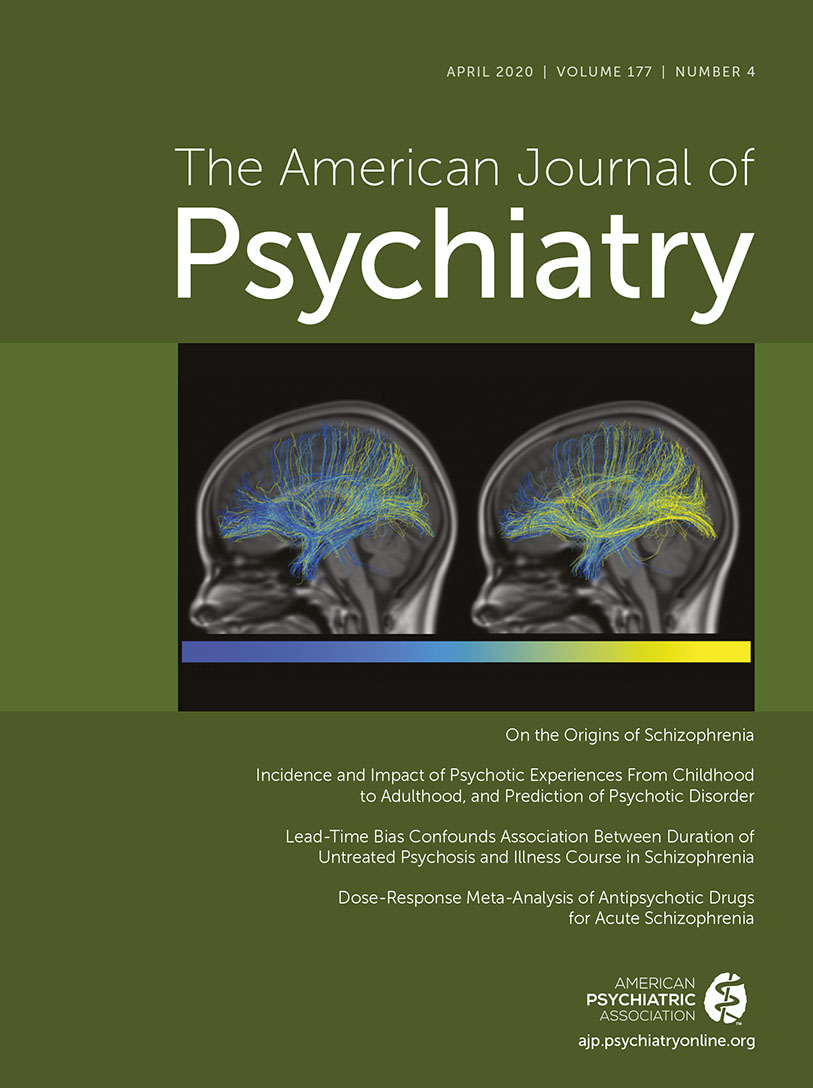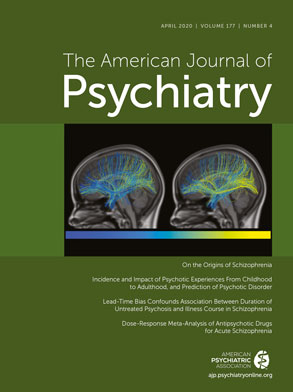Since the turn of the century, the study of psychotic experiences in the general population has emerged as a major paradigm in mental health research. We now know that psychotic experiences are a relatively prevalent phenomenon, particularly in children and adolescents (
1). They do not occur randomly and are clustered with other psychopathology (
2–
4), poor functioning (
5,
6), and suicidal thoughts and behaviors (
4,
7). A systematic review (
3) has shown that psychotic experiences in childhood and adolescence are associated with a fourfold increased risk of a later psychotic disorder but that evidence for longitudinal associations with nonpsychotic disorders is sparse. Recent work has shown that psychotic experiences by themselves appear to have low predictive value and low sensitivity for predicting a later psychotic disorder (
8) and that a more nuanced approach is needed to harness the predictive power of psychotic experiences.
In this issue of the
Journal, Rimvall and colleagues (
9) use the power of the Danish national registries to answer some important questions about the prognostic value of childhood psychotic experiences for mental health diagnoses and treatment in adolescence. In particular, they are interested in examining the unique predictive power of psychotic experiences compared with researcher-diagnosed psychopathology for subsequent diagnoses and treatment. The researchers elegantly use record linkage with administrative data from hospital and prescription registers to obtain complete follow-up data to age 17 for a cohort of 1,572 children who underwent detailed clinical assessment at age 11 using the Development and Well-Being Assessment (DAWBA) (
10) and who were also assessed for psychotic experiences.
In this way, Rimvall and colleagues showed that children with either a DAWBA diagnosis or psychotic experiences at age 11 had an approximately threefold increased risk of diagnosis and treatment from child and adolescent mental health services by ages 16–17, whereas children who had both a DAWBA diagnosis and psychotic experiences at age 11 had an almost eightfold risk of a later mental disorder diagnosis and an almost 10-fold increased risk of psychopharmacological treatment by ages 16–17. These remarkable effect sizes for poor adolescent outcomes call into question our “wait and see” approach to childhood mental health problems.
The authors also found that children with a parental history of mental disorders had a twofold increased risk of a later mental disorder, while children with a family history of parental mental disorders and who also reported psychotic experiences had a fourfold increased risk of mental disorders and a sixfold increased risk of psychopharmacology treatment. These findings demonstrate that reporting psychotic experiences in childhood has a synergistic effect on risks posed by either existing psychopathology or parental mental health history.
From the data provided in this study, we estimated that about one in three youths who had both signs of psychopathology and psychotic experiences at age 11 developed a treatable mental disorder within the next 5 years. Therefore, it appears that Rimvall and colleagues have identified a peripubertal “ultra-high-risk” group for subsequent psychiatric outcomes. These risks are manifested in diagnosed disorders, contact with child and adolescent health services, and psychopharmacological treatment. It now behooves us to consider how to translate these findings back to clinical practice, and in order to do that we must address two further questions. Firstly, how do we identify youths who are at risk? Secondly, how can we intervene in youths who are at risk to prevent later disorders?
The first step is to develop a screening tool to detect children at high risk of later psychopathology that can be easily and efficiently used in school settings. The DAWBA, although an excellent instrument, is too protracted to be used in such a setting (the parent interviews alone require roughly 50 minutes to complete). The Strengths and Difficulties Questionnaire (
11) is a short, well-validated screening tool for children and adolescents who are at risk for developing psychopathology but does not contain any questions on psychotic experiences. The past two decades of evidence have demonstrated that psychotic experiences have earned their place in the assessment of psychopathology alongside internalizing and externalizing problems and can no longer be ignored (
12–
14). As indicated by the findings in this issue, a screening tool based on current psychopathology alone or psychotic experiences alone will fail to identify the majority of children who will go on to have a subsequent disorder. Combining information about current psychopathology psychometrics with psychotic experiences will improve the identification of youths who are at risk of a later mental disorder. In addition to psychopathology, such a screening tool could include information on risk factors for psychopathology, such as adversity and family history of mental disorders.
The ultimate aim of identification of youths who are at risk is to intervene to prevent mental disorder outcomes, and this can be achieved by targeting known risk factors and enhancing known protective factors (
15). Some clues about protective factors for psychotic experiences have emerged from recent literature. Bullying cessation (
16) and improving self-concept (self-esteem) (
17) are associated with significant reductions in incidence of psychotic experiences and will confer benefits more broadly in terms of improving well-being.
It is well known that trauma and childhood adversity increase the risk of mental health problems, including psychotic experiences (
18,
19). Therefore, it is important to detect potentially modifiable factors that mitigate the effects of early adversity. Higher levels of neighborhood cohesion are associated with reduced risks of psychotic experiences among polyvictimized youths (
20), and social support from peers has been shown to have a protective effect on psychotic experiences among polyvictimized youths (particularly girls) (
21).
The parent-child relationship has emerged as a key target for preventive intervention, particularly among individuals who have experienced adversity. We recently demonstrated that parent-child conflict mediated almost half of the relationship between childhood adversity and persisting externalizing problems in a general population sample (
22). Parental support (“My parents help with decision making”) and parental supervision (“My parents know how my free time is spent”) have been shown to mediate the relationship between adversity and psychotic experiences in adolescents (
23). An innovative mixed-methods study demonstrated that a secure attachment relationship with an adult (a parent or nonparent figure) is key to good outcomes in adulthood among youths with early adversity and psychotic experiences (
24).
These findings provide a blueprint for how to approach prevention among youths who are at risk of developing psychopathology. Fostering self-esteem, improving parent-child relationships, promoting secure attachment relationships with trusted others, increasing social and neighborhood supports, and reducing bullying all play a part in improving outcomes for at-risk youths.
Screening for learning difficulties in school and providing additional resource-teaching hours is now common in many countries. Screening children for dental and visual problems and providing early intervention when needed is also accepted practice. Why can’t we do the same for mental health difficulties? Alongside more general health promotion initiatives, we should move to a model of indicated and selective prevention among youths (
15). Prevention has been proposed as one of the grand challenges for global mental health (
25) and has been estimated to be highly cost effective, with savings of up to $83 for every one dollar spent on health promotion and prevention (
26). Because mental disorders begin in early life, there would be a large subsequent effect on reducing health service, social service, and justice system use in later years (
27).
The title of this editorial refers to the novel
We Need to Talk About Kevin (
28), which tells the story of a troubled youth for whom warning signs of mental health problems are ignored until it is too late, and tragedy ensues. We cannot continue to ignore the example set by other medical fields, such as cardiology and oncology, particularly because the dividends of prevention are potentially much greater for mental health than for physical health (
15,
27). The field of psychiatry should now shift its focus to a public mental health approach and face up to the grand challenge of prevention for the sake of our future generations (
29).

